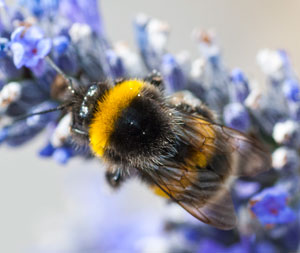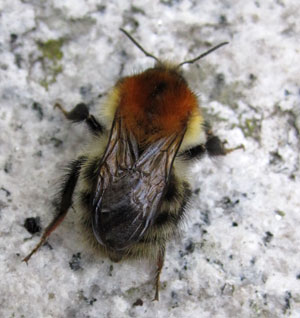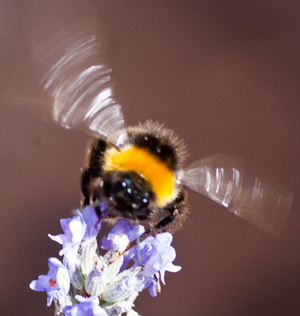Bumblebees

Bumblebees are regarded as nice, gentle creatures; even their buzzing has a placid, reassuring sound. They rarely sting and are important pollinators in orchards, on farms and in our gardens. Sadly, however, they are under threat. Many species of bumblebee are on the decline and have been, according to some authors, since the late 1950’s.
Their decline is often attributed to the introduction of intensive agricultural techniques. For example, the introduction of drainage schemes can result in the loss of marsh plants, whilst the removal of hedgerows means not only the loss of plant species but also habitat for bumblebee colonies. The neglect or removal of coppiced woodland, together with the replacement of deciduous woodland with coniferous has resulted in various plant species having a more limited distribution.
Some species of bumblebee like the apple and short haired bumblebee are now believed to be extinct. Those that remain could be under a new threat – namely imported foreign bumblebees! The mediterranean subspecies Bombus terrestris dalmatinus is being used in some commercial greenhouses to pollinate tomato plants (to improve the yield). Some ecologists fear that these imported bumblebees could undermine the genetic make-up of our own bumblebees or even out-compete certain native types. The imported bees can collect more nectar and produce bigger colonies.
There might be another problem for the bumblebees; as numbers decline, they are more likely to inbreed. If a queen mates with a relative, then some of the genetically female eggs develop into sterile males – which contribute nothing to the colony’s present or future.
 Like ants, wasps and honey bees, bumblebees are social insects ; that is, they live in colonies. A colony contains a queen, workers and some males (depending on the time of year) but only queens can survive through a winter. The queens usually over-winter underground, or in leaf litter or rotten wood in a specially prepared cell. In spring, they emerge and prepare to make a nest. Some species prepare a nest or colony underground, using something like an old mouse burrow; others create a nest on the surface. The creation of a colony is dependent on the queens, who mated at the end of the previous summer and then over-wintered, being able to forage and find food, build a nest and lay eggs. The pollen, which accumulates on the hairs on the body, is combed off into special pollen baskets on the back legs. Each nest or colony needs a fairly large area over which to forage – without competition.
Like ants, wasps and honey bees, bumblebees are social insects ; that is, they live in colonies. A colony contains a queen, workers and some males (depending on the time of year) but only queens can survive through a winter. The queens usually over-winter underground, or in leaf litter or rotten wood in a specially prepared cell. In spring, they emerge and prepare to make a nest. Some species prepare a nest or colony underground, using something like an old mouse burrow; others create a nest on the surface. The creation of a colony is dependent on the queens, who mated at the end of the previous summer and then over-wintered, being able to forage and find food, build a nest and lay eggs. The pollen, which accumulates on the hairs on the body, is combed off into special pollen baskets on the back legs. Each nest or colony needs a fairly large area over which to forage – without competition.
The first eggs (to be laid by the queen) hatch to give infertile females or workers. They take on the task of foraging and collection of food from the queen. The workers forage (over a distance of about half a mile) for nectar and gather pollen. Different species of bumblebees have different flower preferences, but all bumblebees need to visit a variety of different plant species, as they are active from early spring through to late summer. On a daily basis, they can be seen searching for nectar and pollen from early morning right through to the evening. They are active on days when it is too cold or rainy for other insects to fly – they can warm themselves up ready for flying using something similar to our shivering mechanism. At some point, later in the year, when the colony is bigger, some of the (unfertilised) eggs will produce males, which will mate with the new queens that emerge from other eggs.
 To help gather more information about bumblebees, the Bumblebee Conservation Trust has now gained the use of the first bumblebee sniffer dog – called Quinn. He has been trained to locate bumblebee nests, which are difficult to pin point often being concealed in grass and having just a small entrance / exit. Only by mapping the locations of nests can researchers build up an accurate picture of the changes in bumblebee populations. Quinn’s first job will be tracking down bumblebee nests on the Hebrides.
To help gather more information about bumblebees, the Bumblebee Conservation Trust has now gained the use of the first bumblebee sniffer dog – called Quinn. He has been trained to locate bumblebee nests, which are difficult to pin point often being concealed in grass and having just a small entrance / exit. Only by mapping the locations of nests can researchers build up an accurate picture of the changes in bumblebee populations. Quinn’s first job will be tracking down bumblebee nests on the Hebrides.
However, we can do our bit to encourage bumblebees. For example, our gardens can offer a rich and diverse supply of nectar producing plants throughout the spring and summer months; species like lavender, rosemary, geraniums, foxglove and heathers are especially attractive. Farmers are also being encouraged to help stop the decline in numbers by sowing a clover mixture around the edges of some fields (Operation bumblebee).
Comments are closed for this post.
Discussion
[…] in towns and cities, we can help many animal species – such as sparrows, hedgehogs, thrushes, bumblebees and stag beetles. You can also help in the London Wildlife Trust’s garden wildlife survey and […]
[…] have killed voles and shrews, and the swollen rivers may have been too much for many water voles. Bumblebee nests which are often underground will have been flooded or washed […]
The brown banded carder bee (one of our rarest bumble bees) which is usually found in South east England, where it favours grassland and meadows has been found in one of the nature reserves in Worcestershire.
http://www.wildlifetrusts.org/index.php?section=news&id=3446
[…] of many flowers of both commercial and ecological importance. See also the woodland blog : http://www.woodlands.co.uk/blog/wildlife/bumblebees/ and perhaps visit the website of the Bumblebee Conservation Trust .AKPC_IDS += […]
[…] identified and named, even in the U.K. some 24,000 species can be found. Insects, like bees and bumblebees are economically important in the pollination of many crops (apples etc) and flowers; others like […]
Gardening for Bumblebees – see
http://www.buglife.org.uk/getinvolved/gardening/Create+a+bumblebee-friendly+garden.htm
My wife and I have been sitting in the garden this beautiful sunny morning watching the most wonderful creatures! We have a bumble bee nest in the middle of the lawn in an old mouse hole. They sometimes arrive three at a time, and then expertly manoeuvre to land precisely at the entrance. They are just so charming and hard working, a real wonder of nature.
What I find particularly marvellous is that the first 6 young hatch out and know exactly what to do right away! They go and find the right flowers, collect pollen using their unique “vibrate” method and then find their way back to their little nest, maybe half a mile away! These little guys are so perfectly pre-programmed it totally amazes me.
What a wonderful creator we have to give us such beautiful things to enjoy!
Thank you Jehovah!
I have seen several bumble bees in my garden recently. Yesterday I caught one which was buzzing up the inside of our kitchen window. I caught it in a beer glass and released it in the garden near a Mallow plant which they seem to like
as I noticed several bumble bees flying in and out of it.
Sincerely Jim Hamilton
[…] in towns and cities, we can help many animal species – such as sparrows, hedgehogs, thrushes, bumblebees and stag beetles. You can also help in the London Wildlife Trust’s garden wildlife survey and […]
[…] bean crops, and without it many bee-pollinated plants will disappear. See also Chris’s previous blog on bumblebees. We’ve built one of the flower-pot style nests. I’ll let you know whether we get any […]
The Bumblebee Conservation Trust would like details of any bumblebees in your garden / woodland as part of their 2007 survey – see
http://www.bumblebeeconservationtrust.co.uk/surveys.htm
Perhaps you can help by offering bumblebees a home; a nestbox. Details at http://www.bumblebeeconservationtrust.co.uk/nest_boxes.htm

Learn here which autumn planted bulbs attract bumblebees:
https://www.farmergracy.co.uk/search?q=pollinators
We ship these bulbs to the UK, directly from our Dutch family farms.
Farmer Gracy
28 July, 2016